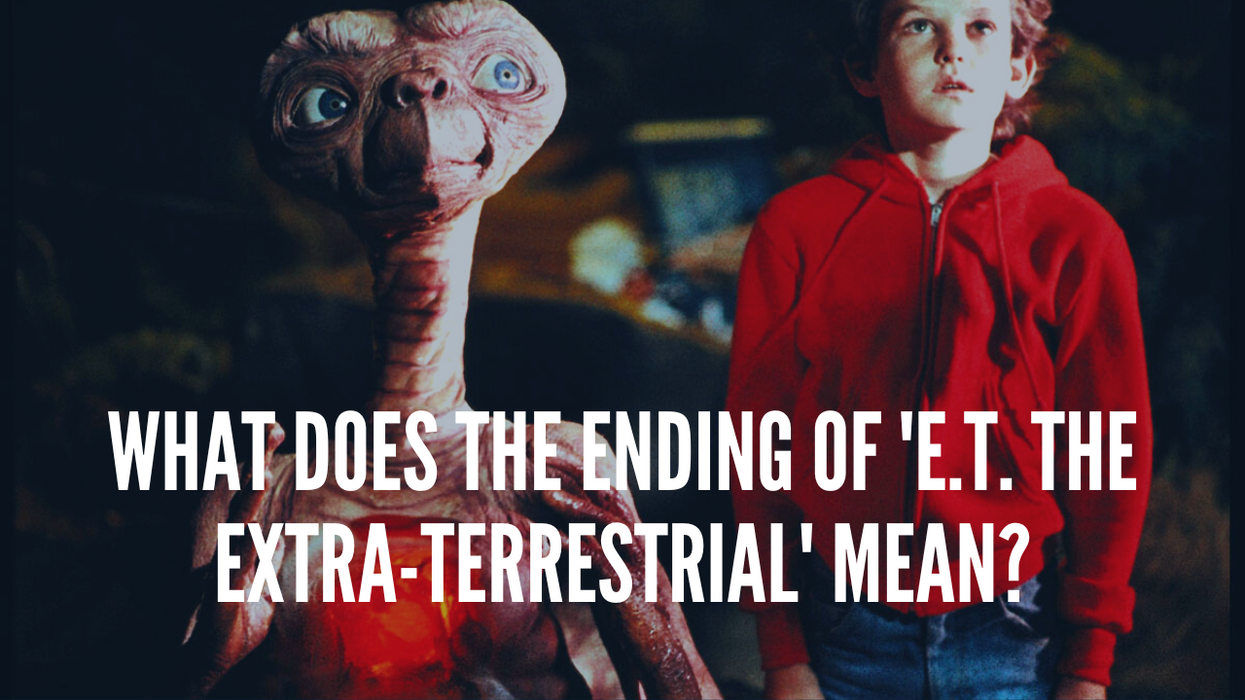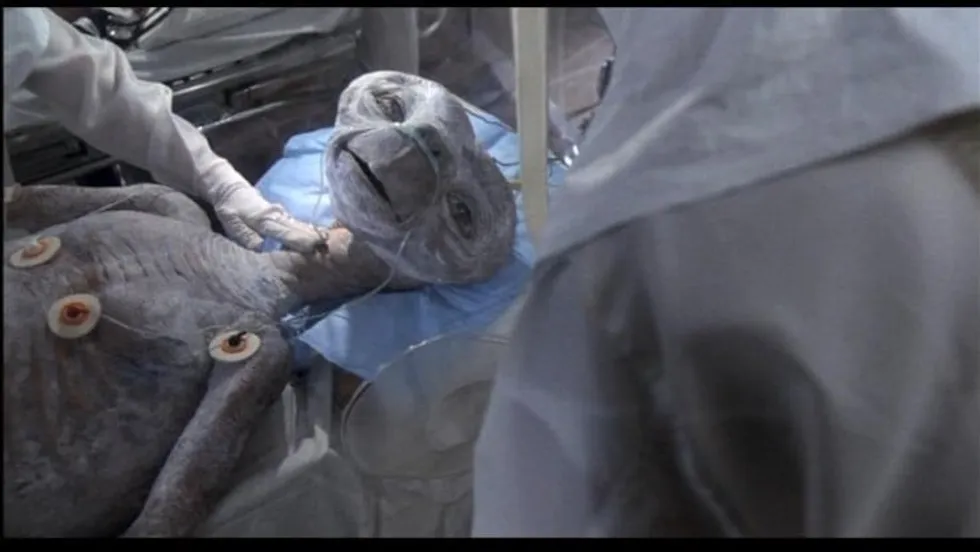Why E.T. Died, and How It’s the Secret to Spielberg’s Masterpiece
Why does E.T. die, and what does the ending of E.T. the Extra-Terrestrial mean?

Few movies have ever had the long- or short-term success of Steven Spielberg's E.T. the Extra-Terrestrial.
But embedded in the all-time blockbuster are some of Spielberg's most powerful messages and most abstract and impactful filmmaking.
At the center of it is the deeply unsettling fact that in the film, E.T. died. For a kid's movie, this is, in the words of the kids of the era, "heavy."
Themes about death and dying are related to ideas of change, growth, and renewal, with implications as core to our existence as anything in all of the narrative. E.T.'s death, and the circumstances surrounding it, are actually the key to understanding the lasting impact of this seminal movie, much more than just "kids' fare."
But why does E.T. die? Why did E.T. get sick? It's not just a technical explanation we are searching for, looking at the clues about his species within the film itself, but also from a larger perspective. E.T.'s character is a powerful concept of metaphor, even within the story.
The E.T. ending helps make the case that all the events surrounding E.T. are metaphors... open to interpretation. As powerful as religion and faith themselves.
When we're done digging into why E.T. died, and what E.T. means, there is little doubt left that E.T. the Extra-Terrestrial stands apart in Spielberg's super accomplished oeuvre as his deepest, most layered, and most artistic film.

Why did E.T. get Sick?
Let's start with the plot itself.
E.T. is a member of a species that comes to earth looking for plant samples. They are, in Speilberg's own words, botanists. When humans disrupt their gentle gathering of samples, they flee to their ship using some sort of psychic heart-based form of communication.
One of them doesn't make it back in time.
E.T.'s sick because he's been cut off from the group for too long. He does, however, form a critical connection temporarily on earth and that's where the film's true meaning blooms.
The stranded E.T. stumbles into the troubled world of a young boy, Elliott. Elliott is stranded in his own way, between multiple stages of life with nobody else who truly understands him.
His older brother Mike is well into teen-dom goofing around with other teen friends. They exclude Elliott from their world. But he also no longer fits as a true child-like younger sister Gertie, who asks her mother to reread the magical story of childhood belief and innocence Peter Pan to her at bedtime.
To add more to it, their father has left them, and the family is fractured and pained as a result.
The powerful connection between E.T. and Elliott grows from their similarity as loners and castaways.
E.T. and Elliott
The connection between E.T. and Elliott leads to multiple magical sequences from Speilberg. It almost comes to symbolize the connection between forms of life... between life and art.. between life and love.
When E.T. is left at home and Elliott goes to school, E.T. gets drunk and watches TV, specifically The Quiet Man starring John Wayne.
In a sequence that captures the relationship between E.T. and Elliott but also between art and life, Elliott begins to get drunk via proxy from E.T.'s beer raid, and begins to free all the frogs in science class being killed for a dissection project (foreshadowing the film's finale), and finally steals a triumphant kiss from a girl in class, perfectly mimicking Wayne and Maureen O'Hara.

We know how deeply connecting the characters are now, but we also are experiencing something unique in Speilberg's entire filmmaking career—cinematic expressionism.
Where so much of Spielberg's career can be defined by a more objective perspective in filmmaking, using the language of edits and shots to create an experience of events as they have happened, E.T. does things entirely differently.
From the very beginning, we are acutely aware that adult faces are often hidden. The world is seen, Charlie Brown-style, from Elliott and E.T.'s height.
But the science class/drinking sequences take things to a new level, breaking the sense of normal reality, making us question if E.T. exists at all, or is truly just a metaphor for Elliott's coming of age.
The answer is actually not important. The power of the emotional experience is now what drives the story.

Why E.T. Dies
E.T. and Elliott have been getting sick for a while, but things come to a head after they finally install E.T.'s crafted communication device, in an attempt to "phone home."
Powerfully again, during the assembly of parts for E.T. in the garage, older brother Mike and Elliott bond over coming across and smelling an old shirt of their father's. They reminisce about the things that are gone. Relics of a more innocent past.
Mike, once the voice of growing up, reassures Elliott. Maybe a happy innocence isn't gone forever.
This is, again, a place where subjective and objective meaning collides within the story. Mike is helping Elliott gather the elements for E.T. to call his home and connect to his life source and people, but Mike is also finally seeing Elliott's pain and trying to help him with that. Elliott, alone earlier in the film, is now close to his brother.
The beacon works in sending its message, but a tired Elliott passes out and E.T. vanishes. Elliott returns home sick, begging Mike to find E.T.
E.T. is in a river, barely alive. After being dragged home by Mike, the adults finally get in on everything, and scientists and law enforcement arrive to quarantine the house.
Elliott and E.T.'s connection frays while they are both in quarantine, and E.T. dies in a prolonged painful sequence that left countless 80s youths traumatized. Everything the scientists do to help fails, Elliott screaming that they're killing E.T.
Something powerful is happening in E.T.'s death from a metaphoric standpoint. What is it, exactly?
It's the idea of youth or innocence being squashed by the adult world, even when the adult world wants to help it or understand it.
It's also the idea that no matter what, we all must grow up. Peter Pan is just a story. Childhood ends. Elliott experiences true loss.
Does E.T. Really Die?
E.T. dies, but then something miraculous occurs. The one adult among the scientists who removes a mask lowers himself to the level of the children and the camera, and seems to understand. This is "Keys." Keys genuinely expresses his sadness over E.T.'s death, and how he had waited for this moment of meeting an E.T. since he was 10 years old. Which is just about Elliott's age.
Why does this matter?
Because it's almost in that moment of an adult understanding that something begins to shift. Keys allows Elliott to have one more moment with E.T.'s body before he is taken away.
As Elliott says goodbye to E.T.'s body he looks down and utters one of the film's most meaningful lines, "Look what they've done to you."
It's almost as if he's referring to the impact of the adult world on childhood and innocence. A reflection of what he's been through. But despite the pain, Elliott fights through tears to say he'll never forget E.T., and he'll always love him.
This, of course, cues the film's magical moment, when E.T.'s people return, his heart comes back online, and he comes back to life.
The idea of a child's love for his own innocence or childhood, of something pure and restorative, not jaded and mature, has brought back life.

The E.T. Ending and the E.T. End Scene
The final scenes from E.T. are, like so much of the film, a powerful swirl of music and image. Dialogue becomes sparse, and dated VFX hardly matters, as emotion through sound and image carries audiences upward like E.T.'s power carries the kid's bikes.
The pack of jaded teens become accomplices in the rescue mission, Elliott becomes a voice of authority now empowered, Mom and Keys watch hopefully... and E.T. is rescued from the scientists and taken back to his mothership.
Spielberg famously let John Williams conduct the score for this sequence without attempting to match it to the edit. Speilberg wanted to match the edit to the work Wiliams did, which is, in a career of transcendent work, truly transcendent.
There was a final scene shot, much like final scenes from the E.T. retread Stranger Things, where the kids are back at the Dungeons and Dragons table, now allowing Elliott a full role as he's become an accepted part of the group.
But the ending scene at the ship was impossible to top, and nothing more needed to be said. E.T. says goodbye to each character in his own way, finally telling tearful Elliott, "I'll be right here," pointing to his head. Implying the power of love, the belief in friendship and innocence... much like the utterance of, "I do believe in fairies," from Peter Pan read aloud to Gertie earlier, will sustain their bond forever.
What Is E.T. the Extra-Terrestrial About?
As the film's 40th anniversary is upon us, and it hits IMAX theaters in limited release, audiences of all ages are reminded that E.T. is about the power of love over jadedness. A child can love absolutely, purely, and without caveat. Adulthood and age are inevitable, but childlike awe and wonderment, love, and willingness to be open to connections like the one to E.T.—these are sustaining forces of good.
Elliott was at a life inflection point where many children are forced to harden into adults to feel safe, to survive the painful realities life throws constantly.
But E.T. provides a reminder that it all need not die forever. Maybe we can find that place in ourselves at any age. Through a movie, or through a sibling, or a parent, or a child, or even an extra-terrestrial.














